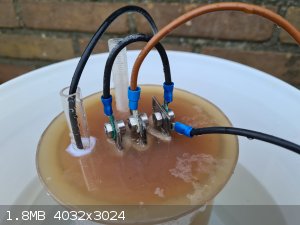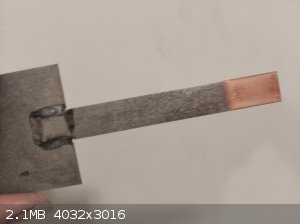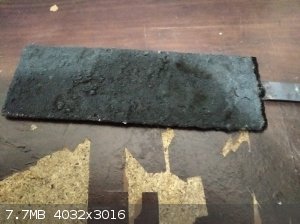HamiltonMaya
Harmless

Posts: 11
Registered: 21-9-2020
Member Is Offline
|
|
Casting busbars for a TSLD anode
Hi all,
I've been trying to make a perchlorate cell using a lead dioxide plated titanium anode, and I'm unsure how best to connect cables to it. I have a
small backyard furnace that's capable of melting aluminum, so I was considering casting an aluminum bar across the top of the anode and then bolting
my cables on to that. I need it to have a good enough connection to handle 50+ amps for a week or more.
I've heard that lead dioxide tends to oxidize other metals over time, and I'm worried that would cause connection problems. I'm also concerned about
the low melting temperature of lead dioxide. So I'm considering exposing the titanium at the top of the anode and then casting on to that. Does anyone
have any experience in similar situations?
|
|
|
vanBassum
Hazard to Self
 
Posts: 66
Registered: 16-4-2019
Member Is Offline
|
|
I have read about guys electroplating the top with copper. I didn't bother with it just used cable lugs screwed directly to the titanium. They do
corrode over time, but I haven't had any problems yet. Then again my current quite a bit lower compared to yours. 50A is a considerable current, if a
connection is dodgy things can heat up and begin to melt. Another possibility is to use 2 cable lugs to the anode and 1 lug per cathode, assuming you
use 2 cathodes.
I've attached a photo of my cell, As you can see corrosion is clearly visible although this will also be the case if you plate them with copper. (The
wire on the left is a temperature probe inside a glass tube.)

[Edited on 8-1-2021 by vanBassum]
|
|
|
mysteriusbhoice
Hazard to Others
  
Posts: 477
Registered: 27-1-2016
Member Is Offline
Mood: Became chemistry catboy Vtuber Nyaa
|
|
Quote: Originally posted by HamiltonMaya  | Hi all,
I've been trying to make a perchlorate cell using a lead dioxide plated titanium anode, and I'm unsure how best to connect cables to it. I have a
small backyard furnace that's capable of melting aluminum, so I was considering casting an aluminum bar across the top of the anode and then bolting
my cables on to that. I need it to have a good enough connection to handle 50+ amps for a week or more.
I've heard that lead dioxide tends to oxidize other metals over time, and I'm worried that would cause connection problems. I'm also concerned about
the low melting temperature of lead dioxide. So I'm considering exposing the titanium at the top of the anode and then casting on to that. Does anyone
have any experience in similar situations? |
Copper plate the electrode contacts and you wont have any problems!!!
you can copper plate directly onto Ti metal if you have NaF as an additive you can even get it from toothpaste and listerine.
copper acetate saturated solution with NaF additive 2.5mg per 500ml of solution and electrodes are 6cm apart with voltage of 3.3 volts.
Also PbO2 cannot be heated to more than 100 or it will convert into Pb3O4 and PbO so aluminum casting is stupid.

[Edited on 8-1-2021 by mysteriusbhoice]
|
|
|
HamiltonMaya
Harmless

Posts: 11
Registered: 21-9-2020
Member Is Offline
|
|
Thank you for the replies! I'll try removing the lead dioxide from the top of the anode and then plating copper onto the titanium.
VanBassum, I really like your idea with the temperature probe, I'll build one of them into my lid as well.
|
|
|
vanBassum
Hazard to Self
 
Posts: 66
Registered: 16-4-2019
Member Is Offline
|
|
I am currently experimenting with electroplating copper on titanium. Thing is, I don't have any NaF. It ain't that expensive, but it will take time to
arrive. I will try it first without additives and maybe toothpaste or NaCl. Oh and glycerine.
So far I have been unsuccessful without additives, the copper doesn't adhere to the titanium and can be easily wiped off.
BTW, I do read on the internet that nickel is used before any other metal is plated. Something to try out as well. Also, the parts should be cleaned
thoroughly any fat or oils will mess up the plating. I clean the parts with alcohol and pre-treat them with HCl.
[Edited on 9-1-2021 by vanBassum]
|
|
|
mysteriusbhoice
Hazard to Others
  
Posts: 477
Registered: 27-1-2016
Member Is Offline
Mood: Became chemistry catboy Vtuber Nyaa
|
|
Quote: Originally posted by vanBassum  | I am currently experimenting with electroplating copper on titanium. Thing is, I don't have any NaF. It ain't that expensive, but it will take time to
arrive. I will try it first without additives and maybe toothpaste or NaCl. Oh and glycerine.
So far I have been unsuccessful without additives, the copper doesn't adhere to the titanium and can be easily wiped off.
BTW, I do read on the internet that nickel is used before any other metal is plated. Something to try out as well. Also, the parts should be cleaned
thoroughly any fat or oils will mess up the plating. I clean the parts with alcohol and pre-treat them with HCl.
you have to also reverse polarity for 15 seconds so the Ti is etched by the NaF in solution before you switch polarity to plate and the reason you add
the NaF into the copper acetate is because it will be all in one and you dont have to risk lifting the Ti piece out of the bath which may oxidize it
again...
NaF dissolves the Ti when its used as an anode which is why its a good etchant for Ti in solution.
[Edited on 9-1-2021 by vanBassum] |
|
|
|
vanBassum
Hazard to Self
 
Posts: 66
Registered: 16-4-2019
Member Is Offline
|
|
Aha, that makes sense. NaCl won't work then because of passivation. I'll just stop dicking around and order some NaF 
|
|
|
mysteriusbhoice
Hazard to Others
  
Posts: 477
Registered: 27-1-2016
Member Is Offline
Mood: Became chemistry catboy Vtuber Nyaa
|
|
I literally used Listerine but be careful and read the back and make sure it says sodium fluoride 220 ppm or sth and you can then concentrate it by
boiling it down.
|
|
|
vanBassum
Hazard to Self
 
Posts: 66
Registered: 16-4-2019
Member Is Offline
|
|
Thanks for the tip, but I already bought some pure NaF. It was 25 euro for 500g so not to bad. I've also read that it is used to increase the
efficiency of the perchlorate cell. Might give that a try as well.
My cell is definitely producing some ozone, the smell is unmistakably 'fresh'. The test with HCl still tests positive, I'll let it run to tomorrow.
I did have another idea to check the chlorate level:
Take a sample and boil it until dry.
Use acetone to dissolve the perchlorate.
Chlorate should be left.
|
|
|
mysteriusbhoice
Hazard to Others
  
Posts: 477
Registered: 27-1-2016
Member Is Offline
Mood: Became chemistry catboy Vtuber Nyaa
|
|
if the anode is Ti substrate I worry the NaF will fuck it up due to the aforementioned direct attack on titanium if theres even a tiny crack. and I
believe that french seller said dont use NaF but instead persulfate for PbO2 electrodes.
Worst case tho if you do fuck up your PbO2 you can just crush up the PbO2 and superglue it onto the Ti before plating it again and it will work
because thats exactly how I made my anode its a polymer composite electrode.
[Edited on 9-1-2021 by mysteriusbhoice]
|
|
|
vanBassum
Hazard to Self
 
Posts: 66
Registered: 16-4-2019
Member Is Offline
|
|
Thanks for the warning, I won't take that chance. Although fixing the anode might be possible, I prefer to not damage it. Besides electricity is much
cheaper than fixing the anode anyway.
I have success with plating nickel to titanium, The electrolyte is just plain vinegar with a dash of salt. The nickel will eventually dissolve and the
solution turns green. That's when the fun starts  After a good layer has
precipitated ill continue with copper. Its quite fun to do and a nice skill to have. After a good layer has
precipitated ill continue with copper. Its quite fun to do and a nice skill to have.
|
|
|
mysteriusbhoice
Hazard to Others
  
Posts: 477
Registered: 27-1-2016
Member Is Offline
Mood: Became chemistry catboy Vtuber Nyaa
|
|
ive damaged and repaired my anode a couple of times, 1 while doing purely testing using a thin plating and the other when I didnt use a glass cell I
let the temp go to 90 Celsius and the coating fell off!! and the current through the cell dropped hard and I had to pickup all the PbO2 pieces and dry
them in for a day before crushing them and gluing them onto the bare Ti electrode before plating more ontop of it.
The electrode hasnt broken since and currently looks like this

The black line ontop is where the solution didnt reach!!
you can see the contrast of the highly conductive beta PbO2 (gray) vs the polymer composite ontop (black)
[Edited on 9-1-2021 by mysteriusbhoice]
|
|
|